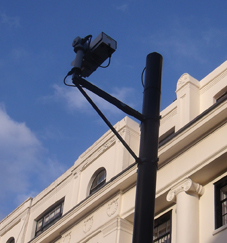Safety cameras, ANPR cameras, besides the security domes and shoebox cameras – it’s a busy streetscape out there, when you add seats, bins, signage, barriers, bollards, parking control equipment, utility cabinets … what’s keeping the streets of London from clutter, even chaos?! How to set standards for how the capital’s streets and public spaces look and feel, and how does CCTV fit in?
Hence a 335-page document, Streetscape Guidance, by Transport for London, which includes CCTV. For the document online, visit http://content.tfl.gov.uk/streetscape-guidance.pdf.
As the guidance points out, cameras are used by TfL and other authorities for several purposes: to enforce traffic regulations such as speed limits, and bus lane restrictions, and the central London Congestion Charge scheme; to assist the police with enforcement duties; and to monitor journey time.
TfL shares some cameras with London boroughs, to reduce proliferation by promoting sharing and multitask equipment. When installing or replacing cameras a priority should be given to renewing or creating partnerships between suppliers to work towards reducing clutter, the transport body says.
As for placement, type and location of cameras is almost entirely governed by the function they are required to perform and the area of view they are required to cover. All cameras impact on the streetscape when mounted on columns. Wherever possible, cameras should be combined with lamp columns or attached to adjacent buildings or structures to reduce clutter; however, expert advice must be sought from an engineer prior to undertaking the work.
Prior to installing a camera on a building, the owner must first give consent and planning and listed building consent must also be sought if necessary. Installing a camera on a building may also require associated legal costs, annual rentals, maintenance agreements and bespoke mounting devices.
When mounting CCTV cameras on lamp columns it is vital to ensure that columns are capable of accommodating the extra load and are rigid enough to minimise camera shake. Where new lamp columns are being installed, consideration should be given to combining lighting with CCTV and roadside cameras. This will require a more rigid column (240mm diameter standard) than is typically installed for lamp columns and mechanical separation of the electrical supply. Designers should also consider the impact of light flare from the adjacent lighting unit.
Where CCTV and roadside cameras are on columns, the control equipment should be located separately in a cabinet on the footway, in accordance with the guidance on traffic signal control cabinets. Camera columns should be aligned in the furniture zone, especially in urban areas.
While some CCTV cameras may be attached to buildings or structures, many are located on high masts. CCTV cameras should be mounted on the most slender poles possible but must not be subject to camera shake. When placed on grass areas there must be enough hard stand around the column and a hard access route across the grass area; this must also be provided for the cabinet and power supply. Roadside cameras require an electrical supply and a clear, unimpeded view of the highway.
There are several types of column that can be used to mount a camera. The location, maintenance requirement and the speed and volume of traffic will influence the type of column used.
Picture by Mark Rowe: on-street CCTV, Mecklenburgh Square, King’s Cross, London WC1.
The document, in its third edition, was launched as part of the Streets Ahead exhibition at New London Architecture (NLA), which runs until the end of February. The guidance gives examples of excellent design to those designing, building, operating and maintaining London’s streets and public spaces. These projects are helping to inform new schemes like the proposals for Aldgate Gyratory, and Elephant & Castle, where traffic-dominated streets are being turned into pedestrian spaces.
Dana Skelley, Director of Asset Management at TfL, said: `We are in the middle of the biggest investment in London’s roads in a generation, ensuring we create places where people want to spend time, where they feel safe and even inspired by their surroundings. We are lucky to have the best urban planners improving and reforming our city in new and exciting ways. This Streetscape Guidance provides the tools and the benefit of years of collective industry knowledge to ensure every project is the best it can be.’










